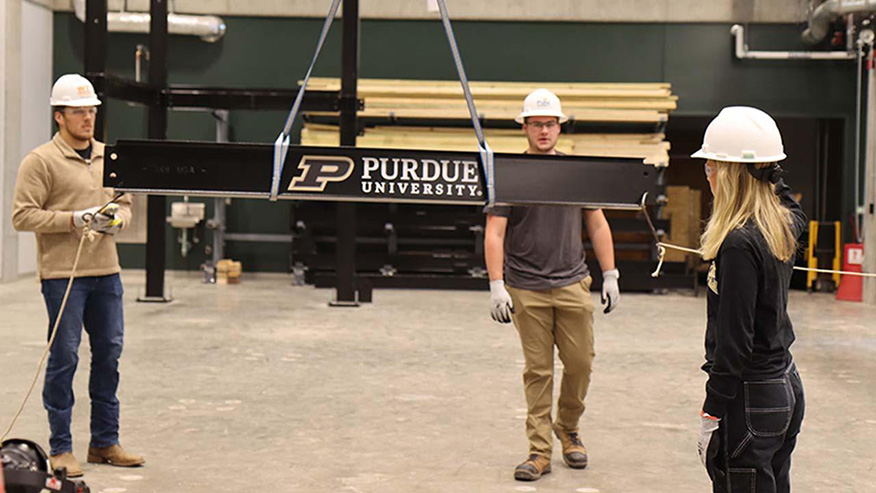Purdue trustees endorse 13th consecutive tuition freeze; approve updated housing, dining plans

WEST LAFAYETTE, Ind. —
The Purdue University Board of Trustees on Friday (Dec. 8) endorsed President Mung Chiang’s request for a 13th consecutive tuition freeze, meaning students will see no increase in tuition through at least the 2025-26 academic year.
Tuition freeze 2025-26
The freeze — to be formally approved by trustees in late spring 2025 per state statute, after the legislative budget setting — means base undergraduate tuition at Purdue will remain at $9,992 per year for Indiana residents and $28,794 for out-of-state students through 2025-26.
“Purdue continues to lead affordability and student access by offering higher education at the highest proven value,” Chiang said. “Each year we evaluate the financial condition of the university, and we continue to grow the 62% part of the annual operating budget that is outside of undergraduate tuition.”
Trustees chair Mike Berghoff said, “While we have become accustomed to annual tuition freezes, making this decision is not something we do automatically. In consultation with the Office of the Treasurer, we carefully evaluate each freeze for viability. We are pleased to endorse President Chiang’s request.”
President Emeritus Mitch Daniels first announced that Purdue would not increase tuition in spring 2013, shortly after he became the university’s 12th president. Before that, Purdue tuition had increased every year since 1976, and it rose an average of nearly 6% annually from 2002-12.

One-year loan borrowing per Purdue undergraduate has decreased by 40% since 2012. Savings for Boilermaker students and their families will total more than $1.4 billion for educational and living expenses by 2025-26, versus what they would have paid if Purdue had raised tuition and fees at the national average. Annual in-state tuition would be $1,400 higher today if Purdue had followed the national trend.
By 2025-26, 11 graduating classes will have never experienced a tuition increase during their time at Purdue.
In 2023, the average earnings-to-debt ratio for Purdue graduates was 6.02.
Housing rates 2024-25: Sustainable quality and continued affordability
While 100% of students pay tuition, about 40% live in university residences. In order to ensure sustainability of quality without subsidy from the other 60% — despite the inflationary increase in the costs of food, construction, repair, insurance and utilities — trustees approved a tiered increase in housing rates for the 2024-25 academic year.
For over 83% of rooms, including those with the highest demand, the average increase will be less than $29 per month. At the same time, Purdue is committed to investing in the maintenance of its residence halls — both rooms and common areas — with a commitment to invest an additional $5 million annually in repairs and rehabilitation for a self-sustaining residence hall system.
After this update, Purdue’s rates will remain the most affordable by a wide margin in 2024-25 among Big Ten universities, as compared to 2012, when its rates were the second-most expensive in the Big Ten.

“As we continue seeing significant demand for on-campus living, Purdue is proud to be taking the necessary steps to sustain quality,” said Beth McCuskey, Purdue vice provost for student life. “Continuing maintenance and enhancements to existing halls will provide quality living and learning environments that position students to succeed.”
Dining rates 2024-25: Simplified flexibility
The Action Council on Student Housing and Well-Being has been collecting input on dining plans. In recognizing that the dining court experience is a core component of residential life at Purdue — one that builds community and supports well-being and success — future meal plans will reflect simplicity and flexibility, as well as affordability. With an annual price ranging from $1,700-$5,695, rates will continue to remain below the Big Ten average, and students can select a plan that fits their needs and budget. Plans will consist of meal swipes used at residential dining facilities and Dining Dollars that can be used at any campus retail location. This eliminates restrictions and confusion on where and when students can eat using their meal plan. Students also will have more flexibility in how they use their meal plans regarding portions, value and time of day.
“On-campus living is such a dynamic piece of the student experience at Purdue, and the trustees extend our thanks to our students and their parents, Purdue Student Government and Purdue Graduate Student Government, and the Action Council on Student Housing and Well-Being for their feedback, input, patience and collaborative work in creating an environment for all Boilermakers to feel at home when it comes to campus life,” Berghoff said.
About Purdue University
Purdue University is a public research institution with excellence at scale. Ranked among top 10 public universities and with two colleges in the top 4 in the United States, Purdue discovers and disseminates knowledge with a quality and at a scale second to none. More than 105,000 students study at Purdue across modalities and locations, with 50,000 in person on the West Lafayette campus. Committed to affordability and accessibility, Purdue’s main campus has frozen tuition 12 years in a row. See how Purdue never stops in the persistent pursuit of the next giant leap, including its first comprehensive urban campus in Indianapolis, the new Mitchell E. Daniels, Jr. School of Business, and Purdue Computes, at https://www.purdue.edu/president/strategic-initiatives.
Media contact: Tim Doty, doty2@purdue.edu
Sources: Mike Berghoff, Mung Chiang, Chris Ruhl, and Beth McCuskey



